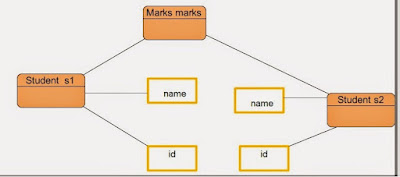Using ‘copy.deepcopy’ method, we can deep copy the list content, whereas ‘copy.copy’ method performs shallow copy.
Let’s see with an example and try to understand deepcopy.
Shallow Copy
A shallow copy just copies the values of the references in the class. Let’s see it by an example.
Let’s take a Student
class, which contains 'marks' object and two fields(name, id).
If we shallow copy Student s1 as Student s2. Then fields other than reference variables are copied as separate variables, but the reference variable 'marks' is same for both student s1 and s2. I.e, a shallow copy just copies the values of the references in the class. So changes to the marks object by student s1 is reflected to s2 and vice versa.
shallow_copy.py
import copy
class Marks:
def __init__(self, maths, physics, chemistry):
self.maths = maths
self.physics = physics
self.chemistry = chemistry
def __str__(self):
return 'maths : ' + str(self.maths) + ', physics : ' + str(self.physics) + ', chemistry : ' + str(self.chemistry)
class Student:
def __init__(self, id, name, marks):
self.id = id
self.name = name
self.marks = marks
def __str__(self):
return 'id : ' + str(self.id) + ', name : ' + self.name + ', marks : [' + str(self.marks) + ']'
marks1 = Marks(75, 91, 87)
student1 = Student(1, 'Krishna', marks1)
student2 = copy.copy(student1)
print('student1 details')
print(student1)
print('\nstudent2 details')
print(student2)
print('\nChange marks, id and name of student2')
student2.marks.maths = 97
student2.marks.physics = 98
student2.marks.chemistry = 99
student2.id = 2
student2.name = 'Lahari'
print('\nstudent1 details')
print(student1)
print('\nstudent2 details')
print(student2)
Output
student1 details id : 1, name : Krishna, marks : [maths : 75, physics : 91, chemistry : 87] student2 details id : 1, name : Krishna, marks : [maths : 75, physics : 91, chemistry : 87] Change marks, id and name of student2 student1 details id : 1, name : Krishna, marks : [maths : 97, physics : 98, chemistry : 99] student2 details id : 2, name : Lahari, marks : [maths : 97, physics : 98, chemistry : 99]
Observe the output, the marks changed by student2 are reflected to s1, but not the name and id(Since these are not references).
Deep copy
A shallow copy is a copy of the reference pointer to the object, whereas a deep copy is a copy of the object itself.
Let’s see it with below example.
deep_copy.py
import copy
class Marks:
def __init__(self, maths, physics, chemistry):
self.maths = maths
self.physics = physics
self.chemistry = chemistry
def __str__(self):
return 'maths : ' + str(self.maths) + ', physics : ' + str(self.physics) + ', chemistry : ' + str(self.chemistry)
class Student:
def __init__(self, id, name, marks):
self.id = id
self.name = name
self.marks = marks
def __str__(self):
return 'id : ' + str(self.id) + ', name : ' + self.name + ', marks : [' + str(self.marks) + ']'
marks1 = Marks(75, 91, 87)
student1 = Student(1, 'Krishna', marks1)
student2 = copy.deepcopy(student1)
print('student1 details')
print(student1)
print('\nstudent2 details')
print(student2)
print('\nChange marks, id and name of student2')
student2.marks.maths = 97
student2.marks.physics = 98
student2.marks.chemistry = 99
student2.id = 2
student2.name = 'Lahari'
print('\nstudent1 details')
print(student1)
print('\nstudent2 details')
print(student2)
Output
student1 details id : 1, name : Krishna, marks : [maths : 75, physics : 91, chemistry : 87] student2 details id : 1, name : Krishna, marks : [maths : 75, physics : 91, chemistry : 87] Change marks, id and name of student2 student1 details id : 1, name : Krishna, marks : [maths : 75, physics : 91, chemistry : 87] student2 details id : 2, name : Lahari, marks : [maths : 97, physics : 98, chemistry : 99]
Previous Next Home


No comments:
Post a Comment